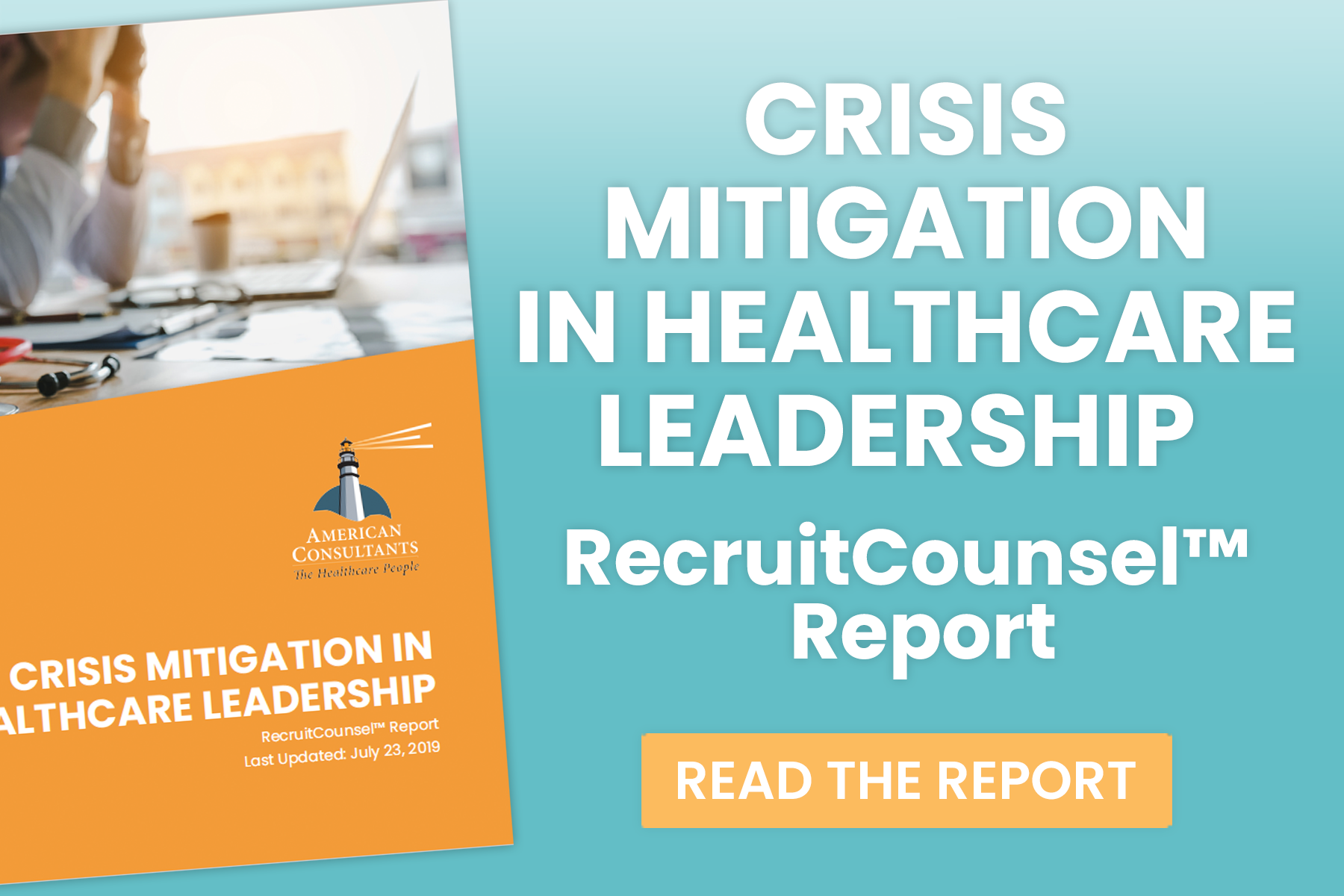
The Unexpected Loss of a Leader
CRISIS OVERVIEW
The unplanned and unexpected loss of an executive or departmental leader can throw a healthcare organization into disarray. Each of a hospital’s departments is critical and must function uninterrupted, yet an unplanned vacancy in management can negatively impact processes, productivity, and profitability
In addition to concerns about operational efficiencies, individual staff member opinions about the cause and effect of the situation leading to the vacancy, replacement strategies, and the change’s impact on their professional trajectory creates an additional layer of complexity for those responsible for relieving the issue.
Voluntary terminations accounted for 92.7% of all hospital separations.
TOP TEN REASONS FOR SEPARATION
1) Personal reasons (caring for a child/parent, marriage, disability, etc.)
2) career advancement
3) relocation
4) retirement
5) salary
6) education
7) scheduling
8) commute/location
9) immediate manager
10) workload/staffing ratios
(2019 National Healthcare Retention Report)
MITIGATION STRATEGIES
DEVELOP A PRE-CRISIS STRATEGY
Like most high-stakes scenarios, pre-crisis planning is a business practice few healthcare organizations can afford to ignore, though it may be tempting to put off when things are going smoothly (and especially when the leadership in charge is doing a great job).
Human resources crisis management planning should begin long before issues arise to craft strategies that can be tested, formalized, and disseminated. Failure to prepare can lead to severe operational, quality, and legal consequences that can add to recovery time, and the hospital may be seen as inept for it’s lack of preparation.
Contingency plans for each managing leader should be in place to cover the first three days, the first week, and the first month. Accurate job descriptions should be on file with HR, organizational charts should be kept current, and the Human Resources Director and other top-level executives should each have go-to personal contacts with executive staffing firms that specialize in healthcare leadership.
LEVERAGE INTERIM TALENT WITHIN 72 HOURS
Skilled interim leaders have comprehensive experience dealing with the challenges and dynamics that come into play during the initial stages of an unexpected vacancy. They understand they may be walking into a complicated and disjointed environment with potentially polarized staff and are trained to diffuse problems.
The stability that the interim provides can also help maintain a sense of importance and respect to the existing leaders within the organization. Without an external interim leader, hospitals often delegate the leadership vacancy to another executive who is likely already at their maximum capacity or may be unprepared for the role. Over-burdening current management with additional responsibilities can lead to burnout and may result in their decision to resign, thus compounding the issue.
Placing a provisional leader within days of the gap provides immediate stability to the department impacted and allows other areas of the organization to operate as usual, minimizing the total impact to operations.
COMMUNICATION AND INDIVIDUAL SUPPORT
An effective interim leader will pay consideration to the personal side of the department’s intricacies, understanding that each staff member has a history and connection with the vacancy that influences the team’s overall success.
While some staff members may regard a new vacancy as a dilemma, others may view it as an opportunity for advancement and friction often develops as a result of numerous internal candidates applying for the open role that requires moderation.
Understanding that their primary function is the stabilization of the department, interim leaders emphasis open and frequent communication about daily activities, share progress on the permanent replacement process and manage individual needs to diffuse stress and avoid additional turnover.
CRITICAL EVALUATION OF THE DEPARTMENT
The roles and responsibilities of hospital executives continuously evolve. Organizations may not have updated job descriptions or performed market-based salary evaluations in many years. Interim leaders can function as an unbiased third party during the transition period to gather the voice and needs of the department with a fresh set of eyes as part of their engagement.
Interim management can also be a valuable resource during internal candidate evaluations in the absence of the previous leader without lingering issues of favoritism or bias. Having a stable short-term leader at the helm while the organization refines new, permanent requirements can help avoid the costly mistake of hiring the wrong candidate.
SEAMLESS CONTINUATION OF STRATEGIC INITIATIVES
Hospitals often plan and implement large projects such as deploying a new or updated EHR or implementing austerity measures over extended periods. These projects are often mission-critical and require significant human and financial capital to complete, so losing an executive leader during implementation can have catastrophic consequences.
The interruption of strategic plans can set back timelines and potentially cost the organization significant financial resources. Interim executive leaders have been involved in many of these types of projects and can hit the ground running, allowing the facility to continue its project implementation with minimal disruption, saving the organization time and money.
With a pre-approved interim strategy, a quick action plan, a caring and open dialog, and coordination with top leadership, keeping control of the impact of an unplanned vacancy is possible to protect the balance of the organization.





